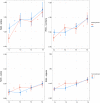(Swiss) GraphoLearn: an app-based tool to support beginning readers
- PMID: 32175013
- PMCID: PMC7048874
- DOI: 10.1186/s41039-020-0125-0
(Swiss) GraphoLearn: an app-based tool to support beginning readers
Abstract
We assessed the Swiss-German version of GraphoLearn, a computer game designed to support reading by training grapheme-phoneme correspondences. A group of 34 children at risk for dyslexia trained three times a week during 14 weeks, on top of their standard school instruction. The sample was divided into two groups of 18 and 16 children, who started training at either the middle or the end of first grade. We found beneficial training effects in pseudoword reading in both training groups and for rapid automatized naming skills in the group that trained earlier. Our results suggest that both the efficiency in phonological decoding and rapid access to verbal representations are susceptible to facilitation by GraphoLearn. These findings confirm the utility of the training software as a tool to support school instruction and reading-related abilities in beginning readers. We discuss ideas to improve the content and outcomes of future versions of the training software.
Keywords: Beginning readers; Children at risk for developmental dyslexia; Computer-based training; Grapheme-phoneme learning; GraphoLearn.
© The Author(s) 2020.
Conflict of interest statement
Competing interestsThe authors declare that they have no competing interests.
Figures


Similar articles
-
Supporting Acquisition of Spelling Skills in Different Orthographies Using an Empirically Validated Digital Learning Environment.Front Psychol. 2021 Apr 6;12:566220. doi: 10.3389/fpsyg.2021.566220. eCollection 2021. Front Psychol. 2021. PMID: 33889104 Free PMC article. Review.
-
Grapheme-Phoneme Learning in an Unknown Orthography: A Study in Typical Reading and Dyslexic Children.Front Psychol. 2018 Aug 15;9:1393. doi: 10.3389/fpsyg.2018.01393. eCollection 2018. Front Psychol. 2018. PMID: 30158886 Free PMC article.
-
[Effects of the Computer-Based Grapho-Phonological Training Lautarium in Children with Developmental Dyslexia].Prax Kinderpsychol Kinderpsychiatr. 2021 May;70(4):333-355. doi: 10.13109/prkk.2021.70.4.333. Prax Kinderpsychol Kinderpsychiatr. 2021. PMID: 33977875 German.
-
Responsiveness to Intervention in Children with Dyslexia.Dyslexia. 2016 Aug;22(3):214-32. doi: 10.1002/dys.1533. Dyslexia. 2016. PMID: 27465208
-
Infant brain responses associated with reading-related skills before school and at school age.Neurophysiol Clin. 2012 Jan-Feb;42(1-2):35-41. doi: 10.1016/j.neucli.2011.08.005. Epub 2011 Sep 17. Neurophysiol Clin. 2012. PMID: 22200340 Review.
Cited by
-
Supporting Acquisition of Spelling Skills in Different Orthographies Using an Empirically Validated Digital Learning Environment.Front Psychol. 2021 Apr 6;12:566220. doi: 10.3389/fpsyg.2021.566220. eCollection 2021. Front Psychol. 2021. PMID: 33889104 Free PMC article. Review.
-
Visual word form processing deficits driven by severity of reading impairments in children with developmental dyslexia.Sci Rep. 2020 Oct 30;10(1):18728. doi: 10.1038/s41598-020-75111-8. Sci Rep. 2020. PMID: 33127943 Free PMC article.
-
Speech therapy to overcome dyslexia in primary schoolers.Sci Rep. 2023 Mar 22;13(1):4686. doi: 10.1038/s41598-023-31631-7. Sci Rep. 2023. PMID: 36949067 Free PMC article.
-
The impact of computer-assisted technology on literacy acquisition during COVID-19-related school closures: Group-level effects and predictors of individual-level outcomes.Front Psychol. 2022 Dec 2;13:1001555. doi: 10.3389/fpsyg.2022.1001555. eCollection 2022. Front Psychol. 2022. PMID: 36533015 Free PMC article.
-
Editorial: The Role of Letter-Speech Sound Integration in Normal and Abnormal Reading Development.Front Psychol. 2020 Jul 7;11:1441. doi: 10.3389/fpsyg.2020.01441. eCollection 2020. Front Psychol. 2020. PMID: 32733324 Free PMC article. No abstract available.
References
-
- Araujo MWB, Charles CA, Weinstein RB, McGuire JA, Parikh-Das AM, Du Q, Gunsolley JC. Meta-analysis of the effect of an essential oil-containing mouth rinse on gingivitis and plaque. Journal of the American Dental Association (1939) 2015;146(8):610–622. doi: 10.1016/j.adaj.2015.02.011. - DOI - PubMed
-
- Aravena S, Tijms J, Snellings P, van der Molen MW. Predicting responsiveness to intervention in dyslexia using dynamic assessment. Learning and Individual Differences. 2016;49:209–215. doi: 10.1016/j.lindif.2016.06.024. - DOI
-
- Blumberg, F. C., & Fisch, S. M. (2013). Introduction: digital games as a context for cognitive development, learning, and developmental research. New Directions for Child and Adolescent Development, 1–9. - PubMed
LinkOut - more resources
Full Text Sources
